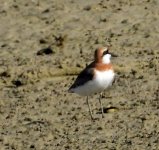Attached are photos of 3, I believe, different sand plovers in breeding plumage. The greatly appreciated comments of John A and others on previous photos have made me want to delve deeper into these, but admittedly without great success.
I have been reading articles in Research Gate, Singapore Birds, Robson's birds of SE Asia and Brazil's Birds of East Asia as well as eBird etc to try and understand further - and of course I identify each plover of the most uncommon possible - reading not being the same as understanding .
.
As to the 3 groups of photos:
Group 1: 24... series: plover with a white spotlights over its eyes separated by a (thick?) line. Is it a Siberian, s. race possibly? In favour are the white forehead spots and the size of the line separating them #2140, the brick red/dark red colour of the breast band and I think a dark line at the top of the breast band - 2143, though sees not to show in other photos. Common redshank in 2142 and Tibetan in2143?
Group 2: # 2139: Greater Sand Plover? long tibia and bill? Terek sandpiper behind?
Group 3: #213d: Tibetan Sand Plover based on short tibia, red-orange breast band.
Are any of these correct?
All comments and corrections greatly appreciated.
thank you in advance
steve
I have been reading articles in Research Gate, Singapore Birds, Robson's birds of SE Asia and Brazil's Birds of East Asia as well as eBird etc to try and understand further - and of course I identify each plover of the most uncommon possible - reading not being the same as understanding
As to the 3 groups of photos:
Group 1: 24... series: plover with a white spotlights over its eyes separated by a (thick?) line. Is it a Siberian, s. race possibly? In favour are the white forehead spots and the size of the line separating them #2140, the brick red/dark red colour of the breast band and I think a dark line at the top of the breast band - 2143, though sees not to show in other photos. Common redshank in 2142 and Tibetan in2143?
Group 2: # 2139: Greater Sand Plover? long tibia and bill? Terek sandpiper behind?
Group 3: #213d: Tibetan Sand Plover based on short tibia, red-orange breast band.
Are any of these correct?
All comments and corrections greatly appreciated.
thank you in advance
steve
Attachments
-
 fullsizeoutput_2144.jpeg262.9 KB · Views: 22
fullsizeoutput_2144.jpeg262.9 KB · Views: 22 -
 fullsizeoutput_2146.jpeg325.1 KB · Views: 21
fullsizeoutput_2146.jpeg325.1 KB · Views: 21 -
 fullsizeoutput_2140.jpeg307.1 KB · Views: 23
fullsizeoutput_2140.jpeg307.1 KB · Views: 23 -
 fullsizeoutput_2142.jpeg515.5 KB · Views: 21
fullsizeoutput_2142.jpeg515.5 KB · Views: 21 -
 fullsizeoutput_2143.jpeg765.7 KB · Views: 19
fullsizeoutput_2143.jpeg765.7 KB · Views: 19 -
 fullsizeoutput_2144.jpeg262.9 KB · Views: 19
fullsizeoutput_2144.jpeg262.9 KB · Views: 19 -
 fullsizeoutput_2139.jpeg218.4 KB · Views: 18
fullsizeoutput_2139.jpeg218.4 KB · Views: 18 -
 fullsizeoutput_213d.jpeg529.1 KB · Views: 20
fullsizeoutput_213d.jpeg529.1 KB · Views: 20



